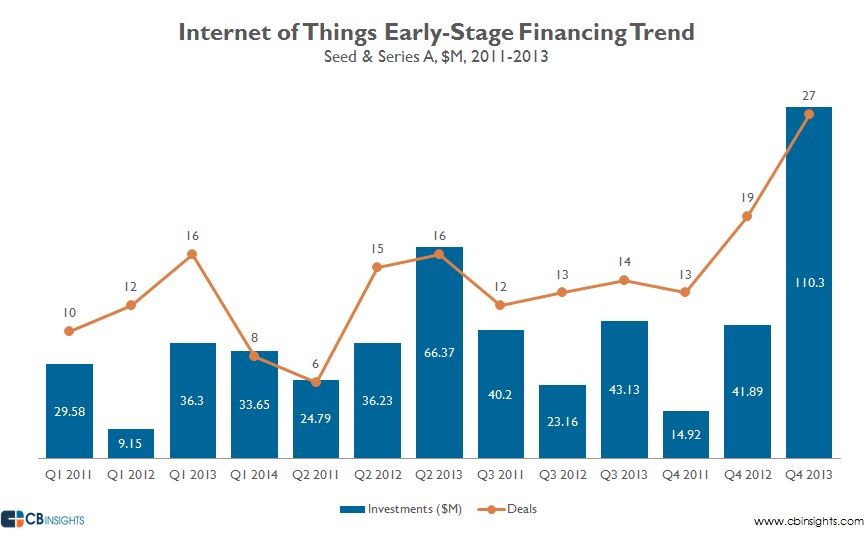Innovation and Industries The Internet of Things
Post on: 7 Апрель, 2015 No Comment

This article originally appeared in Motley Fool Rule Breakers.
A few years back, the Wharton School of Business named the Internet the most important innovation of the past 30 years. The claim is hard to argue. The Internet revolutionized the way we humans exchange information (and also became the name of a Japanese software company and a neo-soul band ).
But our discussion today centers on a new revolution taking shape: the Internet of Things. Just as the (regular) Internet allowed people to exchange information and learn new things, the next wave of innovation will allow devices to communicate with one another — and this opens up a whole new realm of investment opportunities. Let’s take a look.
How It Works
The step-by-step mechanics work like this: Lots of information is collected from devices, that information gets sent across a cellular or wireless network, and it then gets interpreted using appropriate software for the end users. As an example, imagine sensors in your car that communicate your location, then automatically alert you of an accident and suggest an alternate route.
Courtesy of CalAmp.
Step 1: Data collection: Machina Research estimates that nearly 2 billion M2M (machine to machine) devices were connected globally in 2013 and that the number will rise to 18 billion within a decade. These devices can collect data in several forms:
- Consumer companies (like Google ( NASDAQ: GOOG ) ( NASDAQ: GOOGL ) make products (like Glass) that allow users to see the world in an enhanced way, using sensors to provide real-time updates, such as temperature, directions, and location.
- Health care wearable devices continuously monitor patients’ vitals outside of the hospital, then instantaneously notify doctors of anything unusual.
- Retail companies can monitor their shoppers’ buying behavior over time, then offer personalized pricing, optimize store design, and automatically manage inventory to adapt to consumers’ behavior.
- Utilities can improve upon demand response to match regional supply with demand. This could reduce stress on the grid and save consumers in electric costs.
- 1.99 billion other uses that we haven’t even thought of yet; anywhere that devices can offer efficiency or safety advantages over humans could be an opportunity for M2M communication.
Step 2: Data transmission: After device sensors collect the data, it’s transferred over wireless or cellular communications networks. These networks are operated by large telecom players (AT&T. Verizon. Comcast ), but they are badly in need of an upgrade. Cisco ( NASDAQ: CSCO ) estimates that global IP traffic will increase 29% per year through 2016, at which point it will reach 110 exabytes per month (1 exabyte is 1 billion gigabytes). That’s a ton of traffic, and M2M communication will only contribute to the growing need for speedier networks.
Step 3: Data interpretation: Lastly, someone must make sense of all of this data. Application platforms and software providers allow end users to interpret the data and make business decisions from it. Often, as we’ve seen in other experiments. making sense of the data is an even harder task than collecting it.

How to Play This Trend: The Value Network
This isn’t just about talking toasters. McKinsey & Co. estimates that the Internet of Things will have an economic impact of $2.7 trillion to $6.2 trillion annually by 2025 (others have even loftier expectations). For comparison, the entire U.S. federal budget this year will be about $3.7 trillion. So we’re looking at a field that could be at least as large as the current U.S. budget, coming online within a decade. Wow .
As such, we expect everyone to rush in and try to grab a piece of this pie. Companies you’ve never even heard of will claim to focus primarily on machine-to-machine communications. We’ve seen this dance before. The World Wide Web certainly had some early movers that spent heavily to market their expertise (ahem, Pets.com). But regardless of initial claims, the Internet was embraced almost universally within a decade. Similarly, Cisco recently predicted that the Internet of Things would increase corporate profit across all industries by 21% over the next 10 years. In short, the best-performing companies don’t necessarily break the fastest out of the gate.
So as forward-thinking, Rule Breaking investors, we want to separate the wheat from the chaff. I think a concept introduced in The Innovator’s Dilemma can help us. It’s called the value network :
The value network [is] the context within which a firm identifies and responds to customers’ needs, solves problems, procures input, reacts to competitors, and strives for profit. Within a value network, each firm’s competitive strategy, and particularly its past choices of markets, determines its perceptions of the economic value of a new technology. These perceptions, in turn, shape the rewards different firms expect to obtain through pursuit of sustaining and disruptive innovations.
There are three big takeaways from this concept:
- Established companies generally have a preconceived notion of success (such as a minimum margin threshold) required to justify the development of new products. This is often because of existing cost structures, such as a large R&D staff or fixed costs — but it short-sights their vision as they focus only on sustaining innovations that leverage their existing technology know-how.
- Disruptive companies look for opportunities purposely ignored by larger firms. Margins may be slim (or negative) at first, but the disruptors also have much lower cost structures that allow them to pursue these opportunities. The initial addressable market is often very small.
- Ultimately, profit in an industry is defined by the value brought to customers. Companies improve with time to exploit profit — developing capabilities and organizational structures to better provide the things that really matter.
Internet customers eventually defined value as having unlimited monthly access time or a trustworthy e-commerce platform. Companies like AOL and Amazon.com — who built long-term capabilities to provide these — had the stocks that ended up becoming 100-baggers.
So as the Internet of Things matures, we shouldn’t immediately assume that the winners will be the most established or the most profitable companies. Instead, we should try to define what value is for certain industries — then try to find how this new technology can unlock it .
Companies We’re Watching
Sierra Wireless ( NASDAQ: SWIR ) and CalAmp ( NASDAQ: CAMP ) are two companies unlocking value in the automotive industry. Sierra offers all-in-one embedded solutions to get everything in-sync, while CalAmp offers telematic devices to save on fuel costs or to monitor driver behavior. Control4 ( NASDAQ: CTRL ) is another company on our radar, automating appliances, lighting, and other devices throughout your home. Each of these companies provides both the devices to collect data and the software to interpret it.
An alternative take is to look at companies that could benefit by adopting IOT solutions. Manufacturing-heavy companies such as General Electric ( NYSE: GE ) could vastly reduce their production costs, improve efficiency and boost their bottom line. Or the communications networks that are badly in need of an upgrade could certainly use Rule Breakers recommendation Infinera ‘s ( NASDAQ: INFN ) digital-optical network components to provide the fastest Internet speeds available .
The Foolish Bottom Line
One of my favorite parts of Rule Breakers is that we deal with the unknown. We’ve never had an Internet of Things before, so no one knows what it will look like in 10 years.
That said, there’s every indication that this will become a massive movement that affects our everyday lives. As investors, if we can find disruptive companies, unlocking value in huge markets and developing long-term customer relationships, we’ll probably do all right.














